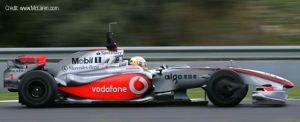The latest episode of the F1 soap opera has a twist that no-one was expecting.
McLaren, having pulled itself back from a £50 million fine and a dispiriting title loss to secure the 2008 World Championship in nail-biting fashion, now appears to have failed to develop a competitive car for this season.
Given the controversies over penalties, and the way the season was decided at the last corner of the Interlagos track, it can often be hard to believe that someone, somewhere, isn’t sat in a production office scripting this stuff in the manner of a professional wrestling series.

But seriously. Just how bad are the problems of the team defending the drivers’ world championship title?
Is this for real?
Earlier this week it appeared the team might be sandbagging – deliberately understating its testing performance to confuse its rivals – and that the clouds might have dispersed into clear blue skies by the season start.
Another theory, one we liked a lot, is that the team which is a byword for buttoned-up discipline might actually be sufficiently organised to circumvent the in-season testing ban by trialling parts for tracks with different levels of downforce, such as Monza and Monaco.
But, sadly it appears not. During the test Lewis Hamilton said that there was still work to do.
And the problems now appear to be all too real with the team badly off the pace in the recent Jerez and Barcelona tests and senior figures at the team acknowledging there may be trouble ahead.
Thoughts of Chairman Ron
During the last week of testing at Barcelona, McLaren chairman Ron Dennis told BBC Sport: “Whatever performance level McLaren have today we will be a competitive racing team. That means we will be fighting for the world championship.
“The objective is to go to Australia and be the most competitive car there, not to come out of every single test at the top of the timesheets.
“Testing is about a disciplined approach to making the car go faster and you have to ignore the performance of the other teams.”
He said the team had deliberately tried to leave its aerodynamic package to the last possible moment before the Australian Grand Prix, a strategy that had caused “some production challenges.”
He added: “We have really only started to run the car in the last day with the Australian aero package. We ran the 2008 rear wing because it was more relevant in its performance to the wing that we are going to have in Australia.
“It doesn’t mean you are lost or that you don’t know what you are doing. Whereas our main competitors are finishing testing in two days we still have the ability to test next week in Jerez. When we get to Australia that will be the first measurement of everyone’s performance.
“We expect our car to go faster with every Grand Prix and we expect to maintain our pace to allow us to win the world championship.”
Managing expectations
But, after the test concluded on Thursday, other senior figures painted a less optimistic picture.
Team principal Martin Whitmarsh admitted: “We are working hard to resolve a performance shortfall.”
And Mercedes motorsport boss Norbert Haug was even gloomier: “We are definitely not fast enough and not competitive enough to aim for wins.”
Whitmarsh acknowledged that the car was not fast enough to meet what he called “the team’s extremely high standards” as a result of problems with its aerodynamic package.
He continued: “Next week we will be testing at Jerez, which many of our rivals will not be. We aim to continue to develop the car, and the result should be measurable on the stopwatch.
“Will MP4-24 be as quick as we want it to be by 29 March? Perhaps not. Will it be quicker than it has been this week at the Barcelona test? Yes.”
And even Dennis’ optimism wavered as he went on to acknowledge that the car’s development was running behind schedule. But he maintained his confidence that team would be race-winners.
It’s the aero, stupid
James Allen, who was in Barcelona and saw the MP4-24 on track, also believes that the team does have a significant problem.
Here’s his analysis:
McLaren admit problem, but how bad is it?
Lap times from this week’s test show progress as the week goes on, but it still leaves the car well behind the pace-setting Brawn Mercedes. The fact that that car uses the same engine as the McLaren adds further pain, because there is clearly no weakness there. The engine appears bullet-proof and has class-leading performance. Mercedes is not the weak link here. The weak link is the chassis and in particularly the aerodynamics.
The Brawn designers appear to have got the new aero rules spot on, whereas the McLaren guys have lost a link in the chain somewhere. Inevitably it has come from the effort that went into winning last year’s championship – think back to the famous $4 million front wing they brought to Interlagos, for example. Ferrari had the same pressure on them, but they seem to have got the 2009 package more sorted and not lost ground to their challengers, like BMW.
The engineers I spoke to believe that McLaren’s problem is more likely to be in the diffuser area, but could also be in how the air is reaching the diffuser under the car. It might be related to the rear wing, but the changes of rear wing could equally be about trying to calm the effect of the diffuser issues. I’m no aerodynamicist and I don’t pretend to understand the science in the slightest. But that is what I heard from people who do. Read full article here…
He concludes that looks like the McLaren is around a second slower, and perhaps more, than Ferrari (never mind Brawn GP) as things currently stand.
It is likely that the team will be able to introduce improvements at Jerez. But will they be enough?
We won’t find out the answer to that question until the last weekend in March.
And, in the meantime, the team’s fans are starting to feel just a little bit nervous.
